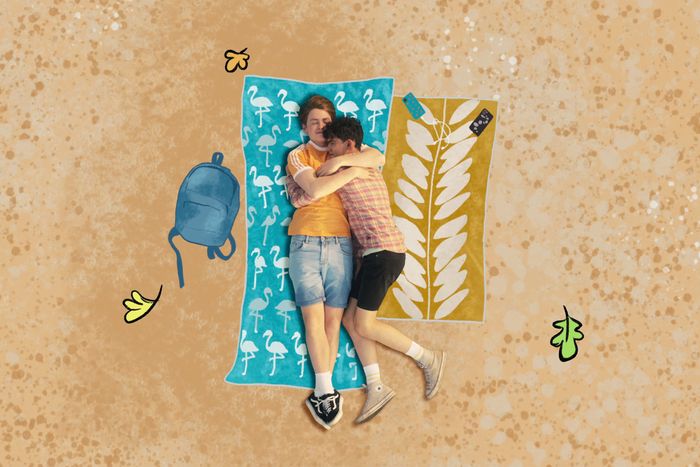
If Heartstopper, the gay YA Netflix rom-com that seems to be gaining fans by the hour, were an emoji, it would be the pleading face: 🥺. Only “pleading” doesn’t sound right. After all, those puppy-dog eyes are more often than not used to express a feeling of cloying sentimentality. You use it when something is just too precious and your emotions feel like they’re about to spill over in rather embarrassing ways.
In fact, those googly eyes are very much what kick-start the romance at the, pun intended, heart of Heartstopper. Adapted from Alice Oseman’s graphic-novel series, it tells the story of two young high-school lads who find their way into each other’s lives and hearts. It’s aggressively heartwarming, the kind of show designed to be described as a warm hug or a cozy blanket; it demands you respond to it, in turn, with “pleading” eyes (🥺). But what’s most striking about Heartstopper, and likely what’s driven it to become such a buzzy title (especially in an American political environment where “Don’t Say Gay” and similar legislation police LGBTQ content for school-age kids) is its ability to tap into an audience famished for cloyingly sweet high-school stories.
When mop-haired Charlie (Joe Locke) learns he’s been assigned a seat next to rugby star Nick (Kit Connor), his initial queasiness at facing a sports lad every morning disappears when he meets his neighbor’s eyes. He’s smitten. Nick, immediately friendlier than any jock Charlie’s encountered, soon convinces his seatmate that he’d be a great addition to the rugby team. There’s clearly chemistry. Sparks, even. Over the course of eight episodes, Charlie and Nick’s relationship grows more and more complicated. Yet both teens are surprisingly mature in navigating what that means, even (or especially) in moments when they agonize over what to text one another, how best to apologize for any perceived slight, and whether they should admit there’s something worth exploring — even if that means reassessing how they each think of themselves. For while Charlie came out (somewhat traumatically) the year before, Nick’s attraction to his new friend urges him to do some Googling on homosexuality and, perhaps more appropriately, bisexuality. Surrounding the pair are two other queer would-be couples, characters briefly sketched out in the graphic novels but here given more heft to provide welcome context and community for what Charlie and Nick are going through.
Heartstopper, like a growing number of LGBTQ YA titles on the screen — think Young Royals, Sex Education, Love, Simon and its spinoff Love, Victor, even the intoxicating Elite — nurtures a kind of phantom nostalgia. Charlie and Nick’s story is the high-school relationship many of us wish we could’ve watched onscreen back when we were teenagers (though some of us did have Willow/Tara and Brian/Justin, I guess). But more to the point, it’s the kind we wish we could’ve experienced ourselves. Oh, if only we’d been able to come out in high school and only had to deal with mild verbal bullying. If only the cute jock we crushed on would’ve turned to us and asked us to hang out, to make out, on a date. If only our coming out would’ve been met by a supportive mom like Olivia Colman (yes, that Olivia Colman!).
Compared to those other titles, Heartstopper stands out for its wholesome appeal, the way it refuses to let melodrama dominate the tenor of its storytelling. Here is a world that feels comforting precisely because its ragged edges have been sanded down, the better to protect characters and viewers alike. There are, to be sure, moments when Charlie and Nick face challenges (bullies at a movie theater, the prospect of a mother struggling with a coming-out speech), but they’re all surprisingly and refreshingly inconsequential. The hopeful vision of the show, best exemplified by the cartoony hearts and leaves that visually call back to Oseman’s graphic novel, steers clear of the trauma so often centered on and in queer stories. In a way, Heartstopper feels of a piece with the David Rose–colored world Dan Levy dreamed up in Schitt’s Creek, where its central gay romance seemed to exist in a society devoid of the usual challenges faced by real-life same-sex couples. But where that Emmy-winning series blazed a trail squarely anchored in the present tense, Heartstopper has the feeling of the subjunctive: Here is a high-school show riddled with hopeful possibilities. Its narratives quite literally ask us to think back on our own experiences and color them in with a wistful sensibility.
Like a phantom limb, this nostalgia feels familiar for those of us who never had it because the tropes Heartstopper is toying with (and only slightly tweaking) are not just well-worn but threadbare at this point. Meet-cutes in class. Hapless run-ins in the hallway. Apologies in the rain. Kisses at the park. For the millennials in the class (the author of this piece included) — and even viewers several decades removed from locker-lined hallways — Oseman’s story prods us to look back for a time we didn’t have but can now imagine for others and even for ourselves. Here is nostalgia as a vehicle for healing.
Therein lies the appeal of gay YA for those of us squarely outside the “young adult” moniker. It offers templates for what could’ve been, yes. But in that phantom nostalgia there’s also a hidden plea for the future these stories can help construct. Just as we force ourselves to wonder how our teenage selves would’ve been changed by having a Nick and Charlie of our own, Heartstopper presents visions for what is yet to come, a world where these relationships are not outliers. They’re the norm. The series is a balm precisely because it soothes us in its wholesomeness, pleading with us to (not forget but) put aside our trauma and revel in this joyful bubble of a world, and maybe carry it with us into our everyday lives.

